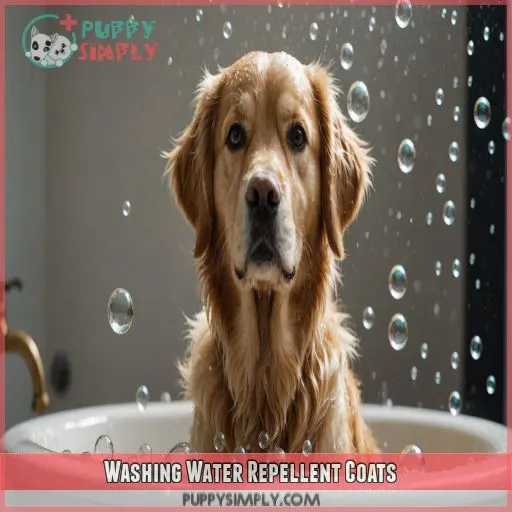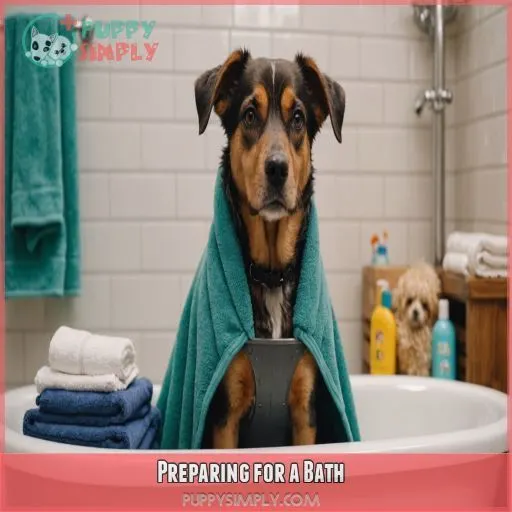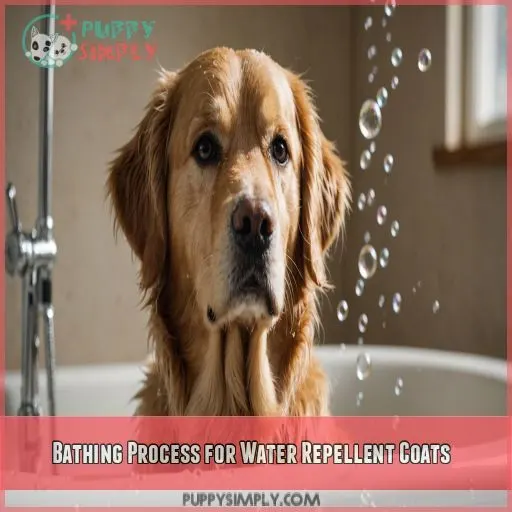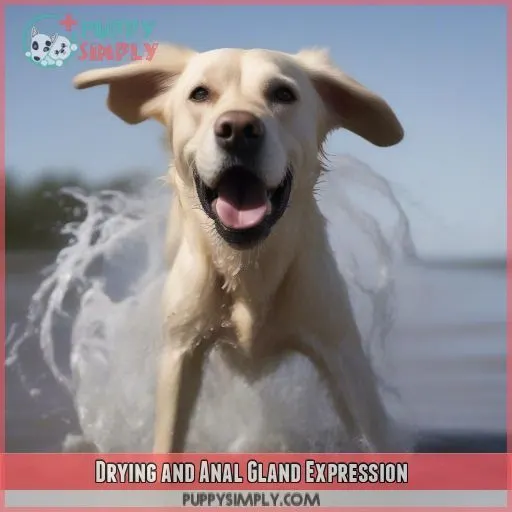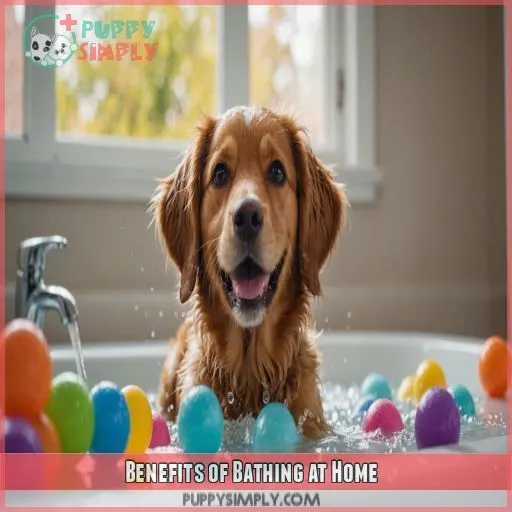This site is supported by our readers. We may earn a commission, at no cost to you, if you purchase through links.
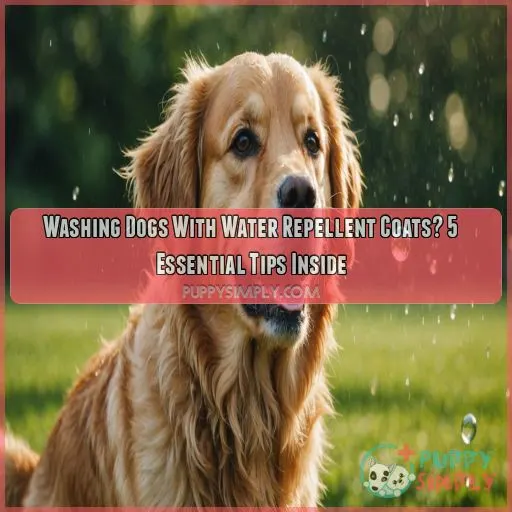
First, brush and comb them thoroughly to remove loose hair and distribute those lovely natural oils.
When it’s time to get wet, use a mild shampoo specifically designed for water-repellent coats, and work from back to front to avoid matting.
Be gentle, and don’t forget to clean those adorable ears!
After the bath, squeeze out excess water, towel-dry, and blow-dry if needed.
By following these tips, you’ll keep your dog’s coat healthy and shiny.
Want to become a pro at bathing your water-repellent-coated friend?
Table Of Contents
- Key Takeaways
- Washing Water Repellent Coats
- Preparing for a Bath
- Bathing Process for Water Repellent Coats
- Drying and Anal Gland Expression
- Benefits of Bathing at Home
- Frequently Asked Questions (FAQs)
- How do you wash a waterproof dog coat?
- Are waterproof coats good for dogs?
- How do you give a resistant dog a bath?
- What not to do when giving your dog a bath?
- How often should I bathe my water-repellent coated dog?
- Can I use human shampoo on my water-repellent coated dog?
- Will frequent bathing ruin my dogs water-repellent coat?
- Should I condition my water-repellent coated dog after bathing?
- Can I use a blow dryer on my water-repellent coated dog?
- Conclusion
Key Takeaways
- When bathing your water-repellent coated dog, brush and comb them thoroughly beforehand to prevent matting and tangling. This pre-bathing routine makes the bathing process much smoother.
- To keep your dog’s water-repellent coat healthy and shiny, use a mild shampoo specifically designed for their coat type. Work from back to front to avoid spreading dirt and debris to clean areas. Be gentle and strategic in your approach.
- You don’t need to bathe your water-repellent coated dog as often as other breeds, but when you do, squeeze out excess water, towel-dry, and blow-dry if needed. Remember to use a cool setting to prevent coat damage.
- To avoid ruining your dog’s water-repellent coat, limit baths to when absolutely necessary. If you do choose to condition, use a lightweight, water-repellent-friendly conditioner. This helps preserve the water-repelling properties of their coat.
Washing Water Repellent Coats
Washing your dog’s water-repellent coat requires some finesse.
Since their natural oils repel dirt, they need fewer baths.
When they do get dirty, use a mild shampoo specifically designed for water-repellent coats.
Avoid over-bathing, as this can strip their coat of its natural oils.
Instead, focus on spot cleaning and regular brushing to keep their coat healthy and shiny.
Preparing for a Bath
You’re about to give your furry friend a bath, and you want to make sure you’re prepared for a stress-free experience for both of you. Before you get started, take a few minutes to brush and comb your dog thoroughly, clean their ears, and grab the right shampoo and equipment to make the bathing process a breeze.
Brushing and Combing Before Bathing
Before bathing your dog with a water-repellent coat, brush and comb them thoroughly. This helps prevent matting and tangling, making the bathing process smoother. Use a dog brush suitable for their coat type to remove loose hair and distribute natural oils. This pre-bath prep makes bath time less stressful for both you and your furry friend.
- Choose the right brush: Select a brush designed for your dog’s coat type to prevent breakage and matting.
- Be gentle: Brush your dog gently, working from head to tail, to avoid causing discomfort or pain.
- Remove mats carefully: Use a detangling spray or conditioner to help remove mats and tangles, taking care not to pull on their hair.
Cleaning Ears and Applying Cotton Balls
Now that you’ve brushed and combed your dog, it’s time to clean those adorable ears! Use a gentle ear cleaning product and cotton balls (not Q-tips!) to wipe away dirt and wax. Choose the right cotton ball size for your dog’s ears to avoid discomfort and make sure you’re cleaning safely.
Choosing the Right Shampoo and Equipment
When choosing the right shampoo and equipment for your water-repellent coated dog, consider shampoos with natural ingredients that won’t strip their coat of its oils. Opt for a large bath tub and sprayer hose for easy rinsing. Don’t forget a sponge, dog conditioner, and drying tools like towels or a blow dryer.
Protecting Yourself With Bath-Proof Clothing
Now that you’ve got the right shampoo and equipment, it’s time to think about protecting yourself from the impending mess! Consider these bath-proof clothing options:
- Waterproof aprons
- Old clothes you don’t mind getting wet
- DIY bath-proof gear like trash bag ponchos
- Clothing with built-in water resistance
- A change of clothes, just in case!
Bathing Process for Water Repellent Coats
You’re about to get up close and personal with your water-repellent coated dog’s bathing process, and we’re here to guide you through it with ease. From wetting their coat to washing their face, we’ll break down the essential steps to keep your furry friend clean, happy, and smelling fresh.
Wetting the Coat and Removing Oily Coatings
Now it’s time to get your dog wet! Use lukewarm water to pre-soak their water-repellent coat, helping to loosen dirt and oils. For particularly oily areas, apply a small amount of dish detergent to break down the oils before rinsing thoroughly. Be gentle, and avoid hot water, which can strip their coat.
Applying Shampoo and Working From Back to Front
When applying shampoo, work from back to front to prevent dirt and debris from spreading to clean areas. Start at the base of the tail and work your way up, lathering the shampoo as you go. Be gentle, especially around sensitive areas, and avoid scrubbing too hard to prevent irritation.
Rinsing Thoroughly and Avoiding Soap Residue
Now that you’ve applied shampoo to your dog’s water-repellent coat, it’s time to rinse thoroughly. Use lukewarm water to remove all soap residue, which can irritate skin and dull the coat. Repeat rinsing until water runs clear, ensuring your dog’s coat health and shine are preserved.
Washing the Face and Avoiding the Eyes
Now, let’s tackle the tricky part – washing your dog’s face without getting shampoo in those adorable eyes! Use a gentle, fragrance-free dog face wash and lukewarm water. Cup your hand to shield their eyes, and work from the outer corner of the eye to avoid any irritation or stinging.
Drying and Anal Gland Expression
Now that you’ve washed your dog’s water-repellent coat, it’s time to dry them off and tackle one of the most glamorous tasks of dog ownership: anal gland expression. Don’t worry, with a little practice, you’ll be a pro at getting your dog squeaky clean and comfortable in no time!
Squeezing Excess Water and Towel-Drying
Time to get your furry friend dry! Gently squeeze excess water from their coat, paying extra attention to ears, tail, and legs. Grab a microfiber dog towel and start drying, being careful not to rub too hard. This helps prevent skin irritation and gets your dog cozy and comfortable faster.
Blow-Drying Long-Haired and Curly-Coated Dogs
Get ready for a blow-drying boot camp! When blow-drying your long-haired or curly-coated dog, use a cool setting to prevent coat damage. Brush their fur in sections, working from the ends up. Be patient, as drying time can take a while. Use a pin brush or slicker brush for detangling.
Expressing Anal Glands Every 8 Weeks
Now that you’ve blow-dried your dog’s coat, it’s time to tackle those anal glands. Don’t worry, it’s not as scary as it sounds! Expressing anal glands every 8 weeks is really important to prevent problems. Here are three things to keep in mind:
- Frequency is key: Regular expression prevents painful issues.
- Home expression is possible: But consult a veterinarian for guidance first.
- Risks are real: Infection, abscesses, and discomfort can occur if not done properly.
Techniques for Expressing Anal Glands Safely
Expressing anal glands safely requires finesse. To avoid any mess or discomfort, follow this step-by-step guide:
| Anal Gland Expression | Pro Tips | Warning Signs |
|---|---|---|
| Hold tail up, squeeze anus | Reward calm behavior with treats | Watch for signs of discomfort |
| Place fingers on either side | Keep your dog relaxed with gentle touch | If unsure, consult a vet |
| Gently push inward and upward | Practice makes perfect, so be patient | Never force or rush the process |
Stay calm, and your dog will too!
Benefits of Bathing at Home
Bathing your dog at home can be a game-changer, especially if your furry friend has a water-repellent coat – it reduces stress for them and saves you time and money. By taking the reins, you get to spend quality time with your dog, make sure they receive proper care, and avoid potential risks associated with professional grooming.
Reduced Stress for the Dog
Bathing your dog at home can be a game-changer for anxious pups! By creating a calm bath environment and using positive reinforcement, you can make the experience enjoyable. Stick to familiar routines, be gentle, and consider a soothing dog massage afterwards to reduce stress and prevent skin irritation.
Cost-Effective and Time-Saving
Bathing your dog at home is a budget-friendly way to keep them clean and healthy. You’ll save money on grooming costs, and you’ll also save time by creating a time-saving routine that works for you and your furry friend.
Here are some bathing hacks to try:
- Use a DIY dog bath to skip the costs of professional grooming
- Invest in a good quality shampoo to reduce the need for frequent baths
- Keep a towel handy to dry your dog quickly and easily
- Use a handheld showerhead to make rinsing a breeze
- Consider a waterless shampoo for a quick refresh between baths
Quality Time With Your Dog
Bathing your dog at home is a great way to spend quality time together. It’s an intimate moment that fosters bonding, much like playtime, training, and cuddles. You’ll strengthen your connection, creating a more trusting relationship.
| Bonding Moments | Benefits |
|---|---|
| Playtime | Exercise, laughter, memories |
| Training | Discipline, communication, trust |
| Grooming | Intimacy, relaxation, connection |
| Cuddles | Affection, warmth, comfort |
| Bath Time | Trust, closeness, play |
Ensuring Proper Care and Avoiding Risks
Bathing your dog at home lets you take charge of their care. You can control the bath frequency, water temp, and shampoo choice. Plus, you can dry them safely and clean their ears with care. By doing it yourself, you avoid risks and make sure your dog gets the best care possible.
Frequently Asked Questions (FAQs)
How do you wash a waterproof dog coat?
Did you know 75% of dogs have a unique coat type that requires special care? When washing your waterproof dog coat, use gentle shampoos, avoid harsh chemicals, and condition thoroughly to preserve their natural oils.
Are waterproof coats good for dogs?
You’re wondering if waterproof coats are good for dogs? Honestly, they’re a blessing for pet owners! Waterproof coats repel dirt and stains, making them a great option for dogs that love playing outside.
How do you give a resistant dog a bath?
Picture a wrestling match, but instead of a mat, it’s a slippery tub! To give a resistant dog a bath, start by brushing them thoroughly, then use positive reinforcement and gentle, calm movements to make the experience less scary.
What not to do when giving your dog a bath?
When giving your dog a bath, don’t rush, use scalding water, or scrub too hard, as this can cause stress, irritation, or even injury. Be gentle, patient, and prepared for a positive experience for both of you.
How often should I bathe my water-repellent coated dog?
You’re lucky! Water-repellent coated dogs need fewer baths, as their natural oils repel dirt. Bathe them every 2-3 months, or when they get really dirty. Less is more for these low-maintenance coats.
Can I use human shampoo on my water-repellent coated dog?
Don’t even think about using human shampoo on your furry friend! It’s like trying to wash a delicate wool sweater with harsh detergent – a recipe for disaster. Instead, opt for a gentle, pH-balanced dog shampoo.
Will frequent bathing ruin my dogs water-repellent coat?
Bathing your water-repellent coated dog too often can strip away its natural oils, ruining the coat’s water-repelling magic. Limit baths to when absolutely necessary, like when they’re really dirty or smelly, to keep their coat healthy and functional.
Should I condition my water-repellent coated dog after bathing?
The million-dollar question: to condition or not to condition? Well, if your furry friend has a water-repellent coat, the answer is a resounding "it depends." If you do choose to condition, use a lightweight, water-repellent-friendly conditioner.
Can I use a blow dryer on my water-repellent coated dog?
If you’re thinking about blow-drying your water-repellent coated dog, it’s generally not necessary – and can even strip their coat of its natural oils. Instead, gently towel-dry them, paying extra attention to their ears and paws.
Conclusion
Oldie but goodie, the basics of bathing your furry friend still apply – even with a water-repellent coat!
By following these 5 essential tips, you’ll be a pro at dog washing and bathing for dogs with water-repellent coats in no time.
Remember to brush, shampoo, and dry with care, and don’t forget those adorable ears!
With practice, you’ll keep your dog’s coat healthy and shiny, and make bath time a breeze for both of you.

